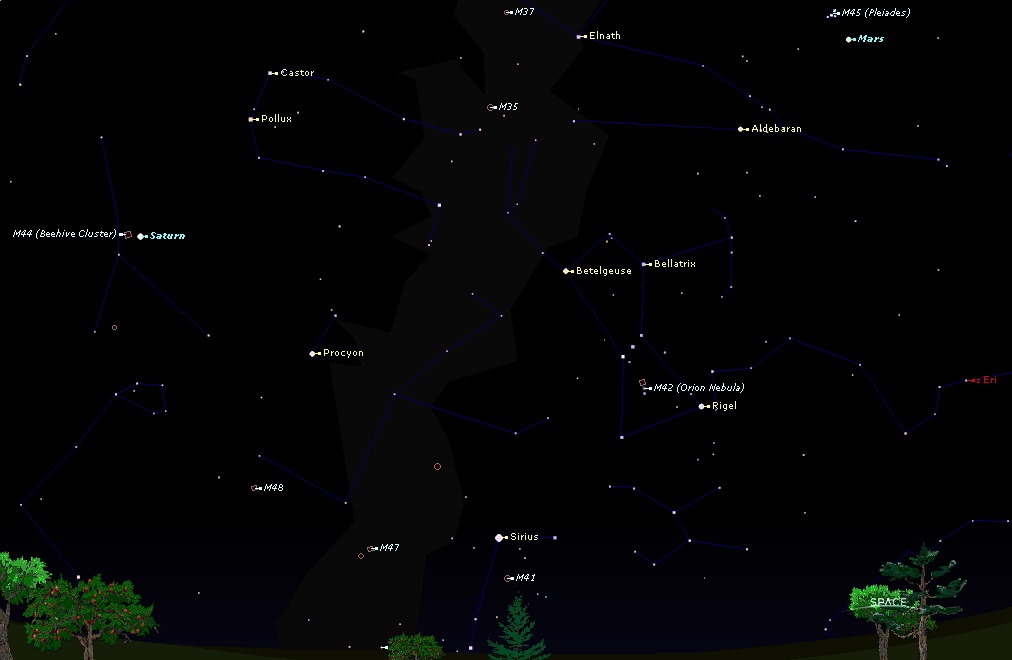|
Orion
|
The constellation of Orion currently dominates the
early evening sky to the south. Its distinctive shape and bright stars
tend to mean it is visible even when viewed from brightly street lit
areas. On the top left of the constellation can be found the red
supergiant star Betelgeuse (a Orionis) and at the bottom right is the
bluish white star Rigel (b Orionis). These two stars are the
10th and the 7th brightest stars in the sky. Betelgeuse is a truly
massive star that is over 1000 times larger than our Sun (put another
way, it has a diameter over 5 times the distance for the Earth to the
Sun) and is about 60,000 times more luminous. Rigel is also a stellar
searchlight being about as luminous, but is much smaller at only
70 times the size of our Sun. |
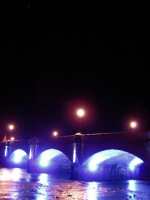
Orion Over Thurso Bridge
|

Orion Over Thurso Bridge Orion and Sirius
15th Feb 06 |
Related Web Links
http://www.astro.uiuc.edu/~kaler/sow/sowlist.html
A website all about stars
http://www.krysstal.com/brightest.html
A list of the brightest stars in the sky and
explanation of star terminology
http://antwrp.gsfc.nasa.gov/apod/ap980419.html
Betelgeuse photo and info
| Also in Orion forming part of the
sword to be found below the 3 stars of his belt, is the Orion Nebula
(M42). This is a region where stars are being formed and is the
easiest viewed example we can see from Caithness being visible to the
naked eye as a small fuzzy patch in the sky. Binoculars or a small
telescope will give a much clearer view of it, but unfortunately they
won't afford a view anything as spectacular as those recently obtained
by the Hubble Space Telescope. But at a cost of more than $2 billion I
suppose you'd expect pretty good photos! |

Orion's Belt, Rigel and M42 |
Related Web Links - M42
http://hubblesite.org/newscenter/newsdesk/archive/releases/2006/01/
- Hubble Panoramic View of Orion Nebula –
Wow!!!!
http://seds.lpl.arizona.edu/messier/m/m042.html
http://www.howstuffworks.com/hubble.htm/printable –
Hubble Space Telescope info
Epsilon Eridani
To the right of the star chart above you'll see the star Epsilon
Eridani labelled. The interesting thing about this star is not just that
it is one of our nearest neighbours (it's just over 10 light years away)
but that it is thought to have planets forming around it.
Related Web Links – Planetary formation
http://www.solstation.com/stars/eps-erid.htm
Planetary systems in the Making spotted in the Orion Nebula
http://hubblesite.org/newscenter/newsdesk/archive/releases/1995/45/image/b
http://hubblesite.org/newscenter/newsdesk/archive/releases/1995/45/image/c
http://seds.lpl.arizona.edu/messier/more/m042_h6.html
http://bcs.whfreeman.com/universe7e/content/ch20/2003003.html
Animation of Protoplanetary Disks in the Orion
Nebula
http://hubblesource.stsci.edu/sources/video/clips/details/stellar-disk.php
http://bcs.whfreeman.com/universe7e/content/ch08/0803002.html
Animation showing the Birth of the Solar System
Sirius
This is the brightest star in the sky and can be found by following an
imaginary line downwards from the 3 stars of Orions belt. Sirius has a
white dwarf companion star, but this is not visible without a very
powerful telescope.
Related Web Links
http://www.astro.uiuc.edu/~kaler/sow/sirius.html
http://www.astro.uiuc.edu/~kaler/sow/star_intro.html#doubles
http://csep10.phys.utk.edu/astr162/lect/binaries/visual.html
Taurus
This constellation can be found above and to the right of Orion.
Following the line of Orions belt upwards will lead you to the bright star
Aldebaran which nestles amongst an open cluster of stars known as the
Hyades. Continuing upwards from this can be found a compact cluster of stars visible that to the naked eye known as
the Pleiades (M45). The stars of the Pleiades are very young by stellar
standards and make a fine sight in binoculars - to me they resemble the
shape of a saucepan. During Feb '06 the planet Mars is to be found just
below the Pleiades.

Taurus and Mars (bottom right) 12th Feb 06
Related Web Links
http://seds.lpl.arizona.edu/messier/m/m045.html
Gemini
The two bright stars in Gemini are Castor and Pollux. Although Pollux
is the brighter of the two it is Castor that is by far the more
interesting. Through a small telescope it can be revealed to consist of
two separate stars, but this is not the full story. Castor actually
consists of a complex system of 6 stars!
Related Web Links – Castor multiple star system info
http://www.solstation.com/stars2/castor6.htm
http://www.eso.org/outreach/eduoff/edu-prog/catchastar/CAS2002/cas-projects/uk_castor_1/intro.html
Beehive Cluster (M44)
To the left of Castor and Pollux is the inconspicuous constellation of
Cancer. This constellation is home to the “Beehive” open star cluster that
is just visible to the naked eye on clear dark nights. This cluster is
well worth looking at through binoculars or a small telescope. One added
bonus at present is that fact that Saturn is very close by (to the right
of the cluster in the photo opposite).
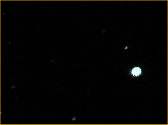
Beehive Cluster & Saturn (15th Feb06)
Related Web Links
http://seds.lpl.arizona.edu/messier/m/m044.html
Planets
Mercury
This planet being so close to the Sun is
always a difficult one to see (I haven't yet!). There is a fairly good
chance of seeing it though during the latter half of February low on the
SW horizon. It should be just visible in the still bright dusk sky shortly
after sunset.
Venus
|
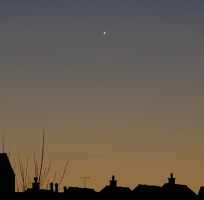
Venus after Sunset Early Jan'06
Crescent shape just visible |
Having been a brilliant object in the evening sky at the start of
January it is currently (mid Feb'06) to be found in the morning sky. It is
easy to distinguish as it remains visible past when all other stars have
disappeared in the brightening sky. With optical aid the planet will be seen to be a thick
crescent shape in February increasing to half phase in March. |
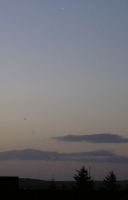
Venus still visible 45 minutes
before sunrise - mid Feb'06 |
Mars
Following its close approach to the Earth late last year it has now
moved far enough away to mean that surface detail is difficult to see
without using larger telescopes. It currently appears as a prominent
orange/red object near the Pleiades.
Related Web Links – Mars Photos
http://hubblesite.org/newscenter/newsdesk/archive/releases/2003/22/
http://www.digitalsky.org.uk/Mars/mars-2005.html
Jupiter
Jupiter is currently visible as a bright object low in the sky to the
south in the early hours of the morning. It is possible to see the four
brightest moons of Jupiter with binoculars and a small telescope will show
up the cloud bands on the planet itself.
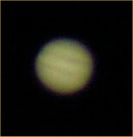
Jupiter through a small telescope
Saturn
Saturn is visible most of the night and although just past its
brightest a small telescope will allow it magnificent rings to be seen.
This is a sight that once seen will never be forgotten. Saturns rings are
currently fairly open when viewed from Earth, but will steadily tilt until
they become edge on in 2009, so this year will be the best chance to view
them for some years. The fact that they are currently very close to the
Beehive Cluster adds to the viewing appeal.
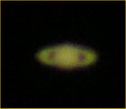
Saturn through a small telescope
Jan'06
Other Events/ Objects of Interest
Solar Eclipse – March 29th 2006
Occurs late morning, but only a small
fraction (less than 20%) of the sun will be seen to be obscured from
Caithness.
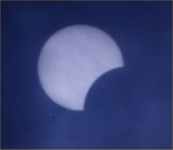
Solar Eclipse - August 1999
Important Safety Note:
Eye safety is very important if
viewing the Sun, even if during an eclipse. See the following link for
advice on this:
http://sunearth.gsfc.nasa.gov/eclipse/SEhelp/safety.html
Lunar Eclipse - 14th March 2006
A penumbral lunar eclipse takes place
starting before midnight on Tuesday 14th March 2006 and continuing past
midnight into the 15th. This particular type of lunar eclipse is unusual
in that the full moon will not disappear, but will darken.
Related Web Links
http://sunearth.gsfc.nasa.gov/eclipse/OH/OH2006.html
Eclipses in 2006
http://www.mreclipse.com/Special/SEprimer.html
Solar Eclipses for Beginners
http://www.mreclipse.com/Special/LEprimer.html
Lunar Eclipses for Beginners
Solar Eclipse
http://www.eclipse.org.uk/eclipse/0212006/index.html
http://www.eclipse.org.uk/eclipse/0212006/Kirkwall_United_Kingdom_2006Mar29.png
Lunar Eclipse
http://www.eclipse.org.uk/eclipse/1132006/
More detailed accounts on what to see each
month can be found on many websites and in most astronomy magazines.
The ones I commonly use are:
http://www.skymaps.com/downloads.html
Monthly SkyMap for Download
http://www.krysstal.com/sky.html
KryssTal Monthly Sky Page
BBC Sky at Night Magazine
Usage of technical terms has been avoided where possible,
but some readers may find the explanations of astronomical terms found at
the following web sites of use:
http://hubblesite.org/reference_desk/glossary/
http://www.delscope.demon.co.uk/astronomy/glossary.htm
G Mackie,
Feb 2006
|
